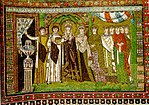 | The Byzantine Empire's history is generally periodised from late antiquity until the Fall of Constantinople in 1453 AD. From the 3rd to 6th centuries,... 138 KB (17,273 words) - 01:26, 6 May 2024 |
 | Latin. The Byzantine Empire was the direct legal continuation of the eastern half of the Roman Empire following the division of the Roman Empire in 395.... 75 KB (1,218 words) - 07:05, 29 April 2024 |
 | The Byzantine Empire experienced cycles of growth and decay over the course of nearly a thousand years, including major losses during the early Muslim... 47 KB (6,461 words) - 21:08, 20 April 2024 |
Hellenisation in the Byzantine Empire describes the spread and intensification of ancient Greek culture, religion and language in the Byzantine Empire. The theory... 20 KB (2,399 words) - 17:53, 21 April 2024 |
Since its fall, the issue of succession to the Byzantine Empire has been a major point of contention both geopolitically, with different states laying... 90 KB (11,728 words) - 16:00, 11 April 2024 |
 | The Empire of Nicaea (Greek: Βασιλεία Ῥωμαίων) or the Nicene Empire was the largest of the three Byzantine Greek rump states founded by the aristocracy... 25 KB (3,100 words) - 15:35, 26 April 2024 |
 | were the main military and administrative divisions of the middle Byzantine Empire. They were established in the mid-7th century in the aftermath of the... 54 KB (4,177 words) - 17:06, 8 April 2024 |
 | of and topical guide to the Byzantine Empire: Byzantine Empire (or Byzantium) – the Constantinople-centred Roman Empire of the Middle Ages. It is also... 17 KB (1,539 words) - 21:31, 20 April 2024 |
were numerous and had significant roles throughout the history of the Byzantine Empire. After the decline of the Greek-speaking Hellenistic Judaism in ancient... 27 KB (3,745 words) - 04:11, 22 February 2024 |
Subdivisions of the Byzantine Empire were administrative units of the Eastern Roman or Byzantine Empire (330–1453). The Empire had a developed administrative... 12 KB (1,282 words) - 11:09, 11 February 2023 |
Roman church, or the Byzantine church, although some of those terms are also used for wider communions extending outside the Roman Empire. The Eastern Orthodox... 61 KB (6,942 words) - 17:23, 23 February 2024 |
For most of its history, the Eastern Roman (Byzantine) Empire did not use heraldry in the Western European sense of permanent motifs transmitted through... 43 KB (5,206 words) - 08:01, 12 April 2024 |
 | The Byzantine Empire was ruled by emperors of the dynasty of Heraclius between 610 and 711. The Heraclians presided over a period of cataclysmic events... 71 KB (8,716 words) - 17:33, 11 April 2024 |
 | Slavery was common in the early Roman Empire and Classical Greece. It was legal in the Byzantine Empire but it was transformed significantly from the... 10 KB (1,330 words) - 22:35, 17 April 2024 |
 | Caesar (title) (redirect from Caesar of the Byzantine Empire) remained a senior court title in the Eastern or Byzantine Empire. Originally, as in the classical Roman Empire, it was used for the heir apparent, and was... 40 KB (3,966 words) - 01:49, 13 March 2024 |
 | The Byzantine Empire was ruled by the Palaiologos dynasty in the period between 1261 and 1453, from the restoration of Byzantine rule to Constantinople... 64 KB (8,460 words) - 10:27, 6 April 2024 |
 | military unit and administrative territorial entity of the middle Byzantine Empire. Its name, like the Latin bandus and bandum ("ensign, banner"), had... 6 KB (563 words) - 23:50, 10 April 2021 |
 | Fall of Constantinople (redirect from End of the Byzantine Empire) of Constantinople, was the capture of the capital of the Byzantine Empire by the Ottoman Empire. The city was captured on 29 May 1453 as part of the culmination... 113 KB (12,837 words) - 22:36, 6 May 2024 |
A reason for the longevity of the Byzantine Empire is how they managed their foreign relations. Armed combat and later its navy were the primary methods... 50 KB (6,441 words) - 05:33, 18 December 2023 |
Byzantine art comprises the body of artistic products of the Eastern Roman Empire, as well as the nations and states that inherited culturally from the... 62 KB (6,897 words) - 07:49, 29 April 2024 |
In the late Byzantine Empire, the term kephale (Greek: κεφαλή, romanized: kephalē, lit. 'head') was used to denote local and provincial governors. It entered... 2 KB (255 words) - 12:58, 6 August 2020 |
 | The Byzantine Empire underwent a golden age under the Justinian dynasty, beginning in 518 AD with the accession of Justin I. Under the Justinian dynasty... 21 KB (2,001 words) - 04:47, 30 April 2024 |







